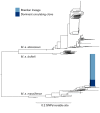Genomic epidemiology of a national outbreak of post-surgical Mycobacterium abscessus wound infections in Brazil
- PMID: 28884021
- PMCID: PMC5562415
- DOI: 10.1099/mgen.0.000111
Genomic epidemiology of a national outbreak of post-surgical Mycobacterium abscessus wound infections in Brazil
Abstract
An epidemic of post-surgical wound infections, caused by a non-tuberculous mycobacterium, has been on-going in Brazil. It has been unclear whether one or multiple lineages are responsible and whether their wide geographical distribution across Brazil is due to spread from a single point source or is the result of human-mediated transmission. 188 isolates, collected from nine Brazilian states, were whole genome sequenced and analysed using phylogenetic and comparative genomic approaches. The isolates from Brazil formed a single clade, which was estimated to have emerged in 2003. We observed temporal and geographic structure within the lineage that enabled us to infer the movement of sub-lineages across Brazil. The genome size of the Brazilian lineage was reduced relative to most strains in the three subspecies of Mycobacterium abscessus and contained a novel plasmid, pMAB02, in addition to the previously described pMAB01 plasmid. One lineage, which emerged just prior to the initial outbreak, is responsible for the epidemic of post-surgical wound infections in Brazil. Phylogenetic analysis indicates that multiple transmission events led to its spread. The presence of a novel plasmid and the reduced genome size suggest that the lineage has undergone adaptation to the surgical niche.
Keywords: Genomic epidemiology; Mycobacterium abscessus; nosocomial infections; outbreak; transmission.
Figures







Similar articles
-
Phylogenomics of Brazilian epidemic isolates of Mycobacterium abscessus subsp. bolletii reveals relationships of global outbreak strains.Infect Genet Evol. 2013 Dec;20:292-7. doi: 10.1016/j.meegid.2013.09.012. Epub 2013 Sep 18. Infect Genet Evol. 2013. PMID: 24055961 Free PMC article.
-
Characterization of mycobacteria from a major Brazilian outbreak suggests that revision of the taxonomic status of members of the Mycobacterium chelonae-M. abscessus group is needed.J Clin Microbiol. 2009 Sep;47(9):2691-8. doi: 10.1128/JCM.00808-09. Epub 2009 Jul 1. J Clin Microbiol. 2009. PMID: 19571015 Free PMC article.
-
Genome reorganization during emergence of host-associated Mycobacterium abscessus.Microb Genom. 2021 Dec;7(12):000706. doi: 10.1099/mgen.0.000706. Microb Genom. 2021. PMID: 34874249 Free PMC article.
-
Epidemiology of Mycobacterium abscessus.Clin Microbiol Infect. 2024 Jun;30(6):712-717. doi: 10.1016/j.cmi.2023.08.035. Epub 2023 Sep 30. Clin Microbiol Infect. 2024. PMID: 37778416 Review.
-
Current significance of the Mycobacterium chelonae-abscessus group.Diagn Microbiol Infect Dis. 2019 Jul;94(3):248-254. doi: 10.1016/j.diagmicrobio.2019.01.021. Epub 2019 Feb 10. Diagn Microbiol Infect Dis. 2019. PMID: 30954313 Review.
Cited by
-
Genome-Scale Characterization of Mycobacterium abscessus Complex Isolates from Portugal.Int J Mol Sci. 2023 Oct 20;24(20):15402. doi: 10.3390/ijms242015402. Int J Mol Sci. 2023. PMID: 37895081 Free PMC article.
-
Whole-Genome Sequences of Mycobacterium abscessus subsp. massiliense Isolates from Brazil.Microbiol Resour Announc. 2021 Jul 15;10(28):e0036121. doi: 10.1128/MRA.00361-21. Epub 2021 Jul 15. Microbiol Resour Announc. 2021. PMID: 34264116 Free PMC article.
-
Epidemiology of Mycobacterium abscessus in England: an observational study.Lancet Microbe. 2021 Oct;2(10):e498-e507. doi: 10.1016/S2666-5247(21)00128-2. Lancet Microbe. 2021. PMID: 34632432 Free PMC article.
-
Tolerance to Glutaraldehyde in Escherichia coli Mediated by Overexpression of the Aldehyde Reductase YqhD by YqhC.Front Microbiol. 2021 Jun 23;12:680553. doi: 10.3389/fmicb.2021.680553. eCollection 2021. Front Microbiol. 2021. PMID: 34248896 Free PMC article.
-
Mycobacterium abscessus: Shapeshifter of the Mycobacterial World.Front Microbiol. 2018 Nov 1;9:2642. doi: 10.3389/fmicb.2018.02642. eCollection 2018. Front Microbiol. 2018. PMID: 30443245 Free PMC article. Review.
References
-
- Tortoli E, Kohl TA, Brown-Elliott BA, Trovato A, Leão SC, et al. Emended description of Mycobacterium abscessus, Mycobacterium abscessus subsp. abscessus and Mycobacterium abscessus subsp. bolletii and designation of Mycobacterium abscessus subsp. massiliense comb. nov. Int J Syst Evol Microbiol. 2016;66:4471–4479. doi: 10.1099/ijsem.0.001376. - DOI - PubMed
Publication types
MeSH terms
Grants and funding
LinkOut - more resources
Full Text Sources
Other Literature Sources
Medical
Molecular Biology Databases

